 |
| Nothing to see here...literally... |
After an expectedly bumpy night, I woke up to an unexpectedly quiet morning as Havila Castor made its way through the sheltered waters of Bøkfjord on our way to Kirkenes. By the time I’d made myself presentable and finished breakfast, the darkness had given way to the shades of blue that were to dominate much of the day, since we were still far enough north for the sun not to rise. As I had my breakfast, I was also thankful for the invention of radar because outside, visibility was pretty much non-existent. In contrast to the previous days on this journey, there was a definite buzz around the ship. Many passengers who had only booked the northbound leg of the coastal voyage would be leaving the ship in Kirkenes, whilst other passengers would be joining the ship for the southbound leg only. Two of the dinner companions that had been at my table since Bergen would be among the departing passengers.
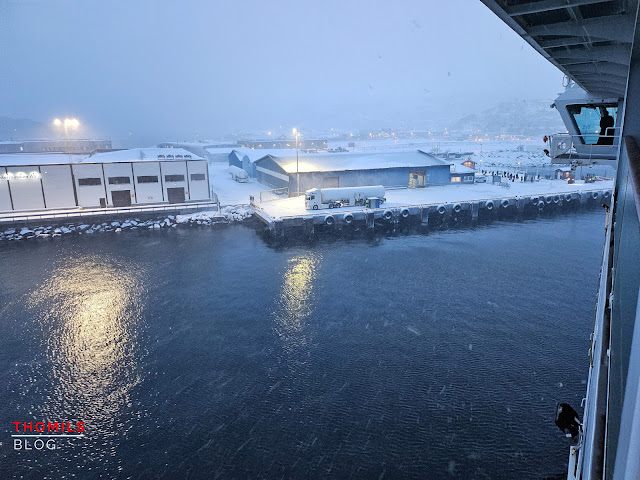 |
| Approaching the pier at Kirkenes. |
 |
| Cleaning crews, passengers, tour buses... The pier side is busy. |
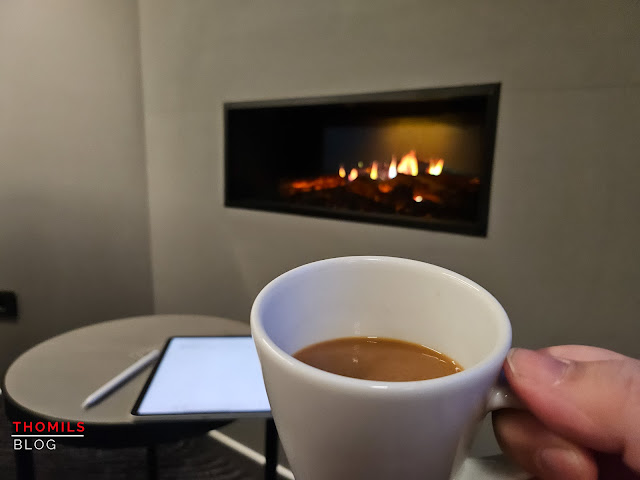 |
| I'm just taking advantage of the fact that the fireside chairs are free for a change. |
 |
| I love the bow lounge! |
The pier in Kirkenes only came into view when we were less than a kilometer away. The welcoming committee was pretty hard to miss. A gaggle of passengers was waiting just outside the port gates in the driving snow, as was a cleaning crew that would help turn the ship around during our four hour stay. Meanwhile, further back, buses were waiting to take the passengers either to the airport, to one of the local hotels, or on one of the excursions. I had, once again, opted to remain aboard, a decision vindicated by the driving snow and poor visibility, and once the initial hubbub of our arrival had subsided, I made my way to the bow lounge to snag my favourite chair by the fireplace to read and just think about things. About the events of the last few months, how I’d walked away from my job, and how my future would look. When I finally got out of that chair, none the wiser about the future, I noticed that we were already getting close to our scheduled departure time. The snowfall had once again intensified by the time I made it to Deck 8. Not only that, but one of the excursion buses hadn’t returned yet. Our scheduled departure time came and went, and still no bus. I was getting a little nervous after my own experience on the North Cape excursion the day before but finally, about twenty minutes past our scheduled departure time, the bus finally pulled up to the quay. As the passengers raced across the snow to get back aboard, I noticed for the first time that there was some sort of bay or inlet right behind the port. That’s how bad the visibility had been for much of our stay in Kirkenes.
 |
| Waiting for Godot... or in our case the last tour bus. |
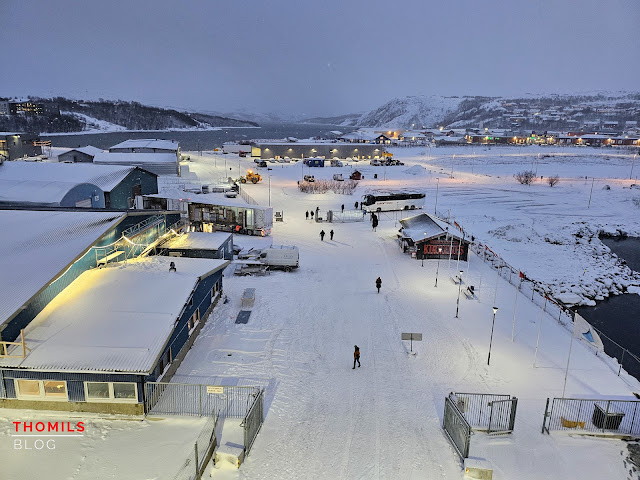 |
| There it is! Also, it took me until that moment to realise that there's a fjord behind our pier! |
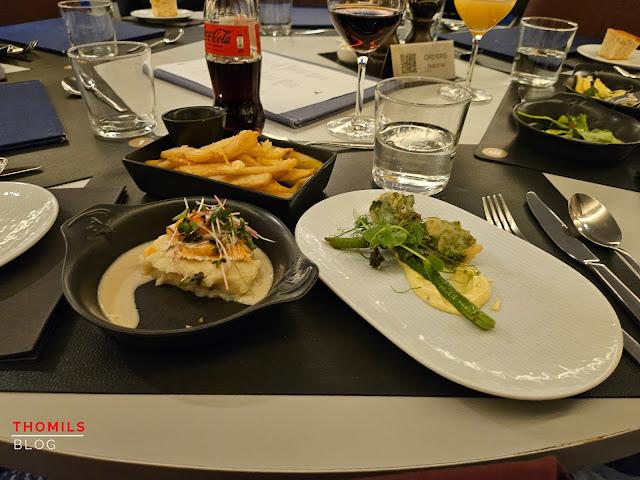 |
| Lunchtime! |
Havila Castor finally slipped her moorings to begin her southbound journey at 1300h, around thirty minutes after our scheduled departure time. Unfortunately, this meant that our stay in Vardø, our next port of call, would be cut down to the bare minimum. I wasn’t too thrilled at this as I was looking forward to that port, but Havila had a schedule to keep, after all, we were a supply ship and coastal ferry just as much as we were a cruise ship. Darkness had long since fallen again by the time we began our approach into Vardø. The passage had become rough as we’d left the protection of the Varangerfjord and entered the Barents Sea, something that would remain with us for the remainder of the journey, at least until we reached the sheltered passages north of Tromsø, a day or two away. As for Vardø, whilst Kirkenes might be closer to Russia at a mere seven kilometers away from the border, it is Vardø that is the easternmost town in Norway, being further east than Kyiv, St. Petersburg or Istanbul. The town is also the best symbol for just how much of a geopolitical tinderbox this area of the world really is. It sits astride the approaches to the Russian Northern Fleet’s submarine bases and ports on the Kola peninsula, creating a natural choke point for any Russian ship trying to head from there into the Atlantic or returning to base. The domes of the GLOBUS space surveillance radar speak to this strategic location and whilst this radar system is ostensibly used to track orbital debris, it is equally well-suited to keep an eye on the Kola peninsula, as it has an uninterrupted line of sight. It stands to reason that this system is supplemented by underwater hydrophone arrays similar to SOSUS, or whatever its replacement is called. Our port call was short, only barely long enough for a quick cargo and passenger exchange and we were soon on our way again.
 |
| The radomes over Vardø make it abundantly clear just how much of a potential flash point the far north of Norway really is. |
I was in the restaurant when we called in Bâtsfjord, our next port. I don’t think I missed much since it was yet another blink-and-you’ll-miss-it stop. Dinner was not something to miss this time around. It started with deep-fried cod cheeks, which came as a surprise since I didn’t even know cod had any cheeks. It was excellent though, and not to be missed. The same was the case for the main course, although I was acutely aware that the reindeer goulash on my plate was depriving a kid somewhere of their Rudolph. I had barely finished the dessert, an excellent white & dark chocolate ice cream, when action stations were sounded. The Northern lights had been spotted again.
 |
| Starting our dinner with deep-fried cod cheeks, a body part that I didn't even know existed... |
 |
| Looks like Rudolph got into some hot water... reindeer goulash as my main! |
 |
| You can't go wrong with white and dark chocolate ice cream! |






When I stepped out onto the outside sections of Deck 9, it became immediately clear that this display was the real deal. The aurora was visible to the naked eye, right down to its colours, and even the horrible motion blur of my phone camera couldn’t hide the sheer magnificence of the sheets of colour writhing high above us. For twenty minutes, I stayed out on the freezing and heaving deck, transfixed by the spectacle playing out all around us. Eventually, the northern lights began to fade, which I took as a signal to turn in. The lack of sunlight was affecting me badly at this point. I did stay up to watch our port call in Berlevåg, the same port where the previous day had ended for me. After we’d waited for a northbound Hurtigruten ship to clear the berth, it quickly became clear that there was simply no cargo waiting for us. With no cargo or passengers of our own to drop off, we turned around and left the dark, lonely pier behind us on our way south.
 |
| Passing a northbound Hurtigruten ship outside Berlevåg. |
November 26th – Day 7
 |
| On our way to Hammerfest. Yep, it's cold! |
 |
| A weapons-grade cinnamon bun and a coffee: The breakfast of champions! ;) |
Overnight, the Barents Sea had made us pay for the spectacle of the northern lights we’d seen the previous evening. It had been a rough passage and I’d been tossed around in bed quite a bit. Still, when my alarm went off, I felt surprisingly good, although I wasn’t sure where I was slowly getting my sea legs or it was just the effects of the seasickness tablets. Showering still turned out to be quite the rodeo, with me once again being thankful for the handholds in the shower, as well as the floor drains and watertight hatch to the bathroom. It took some time for me to get dressed and ready and so I opted for a late breakfast for the café, consisting of a coffee and one of Havila’s excellent cinnamon rolls. Our southbound track was beginning to make itself felt. Whilst the sun still only barely made it over the horizon, the days were just that little bit longer, that little bit brighter. Whilst the landscape was as foreboding and fascinating as it had been on the way north. That sense of “magnificent desolation” I’d mentioned during my abortive excursion to the North Cape was in full swing as we made our way through a number of protected sounds to Hammerfest.
 |
| The best way to describe the view outside is "magnificent desolation"! |
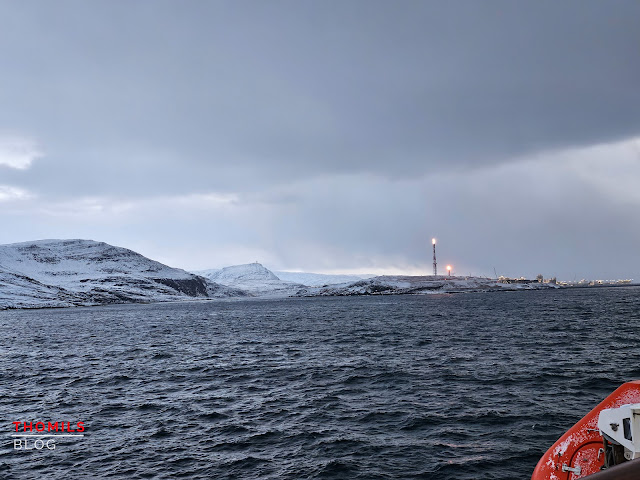 |
| Approaching Melkøya LNG Terminal. |
Even though we were still running late and had to curtail our stay in Hammerfest from nearly two hours to a mere twenty minutes, this was still the big event of the day. As Havila Castor passed along the rugged coast of Kvaløya, a lone, flaming sentinel slowly came into view, the gas flare of the Melkøya LNG plant. The excursion team had invited passengers up to the outdoor areas of Deck 8 for a lecture on the plant, the Snøvhit gas field it served, and the importance of the facility for Norway. All the facts and figures couldn’t hold a candle to the sight itself though. Towering high above the slate-grey waters, framed by the frozen, snow covered landscape and milky grey skies, the gas flare dominated everything, akin to an industrial Sauron looking for the ring bearer. As Havila Castor began to round the little island of Melkøya, the scale of the gas processing plant began to show itself. A warren of pipes, tanks, pumps and other plants had all but consumed the formerly barren islands. The plant’s job was to take raw gas produced by underwater wellheads on the Svnøvhit gas field under the Barents Sea and transported to the island by massive undersea pipelines, purify it and torch off any overpressure or impurities, before liquefying it for storage and transport. Every two days, an LNG taker would come alongside at the plant and take on a full cargo to deliver to an increasingly energy-hungry world. One such tanker was moored at the loading pier was we made our way past the plant and into the port of Hammerfest.


 |
| The terminal on Melkøya in all its glory, with a tanker alongside. |
 |
| Approaching Hammerfest. |
 |
| Helicopter traffic inbound to Hammerfest airport, which is hidden from view by a ridge line. |
 |
| The town of Hammerfest is literally across the bay from our berth. |

Hammerfest was an odd port. We tied up at a quay on the north side of the harbour, directly opposite the town of Hammerfest itself. Even if we’d been on time, it simply wouldn’t have been possible to make it into town and back. As it was, this remote berth, combined with the ever-present fires of Melkøya, gave the entire place an eerie feel. This wasn’t helped by a stream of arriving and departing helicopters and regional airliners operating out of Hammerfest regional airport, with the flight activity easily visible, but the airport itself hidden from view. As it was, this pocket of civilisation, spread across these four different locales and nestled into a hostile environment seemed to me to be eerily reminiscent of Noveria, a level in the first game in the Mass Effect series. To the best of my knowledge, Hammerfest was not infested with alien horrors or homicidal robots though. Does anyone even get these references I put in my blog posts?
Anyway, after a short stay in Hammerfest, we were soon on our way again, inexorably heading south on our way to our next port, Øksfjord. After the hectic activity of Kirkenes, the ship had settled back into its usual routine, much emptier and quieter now on the southbound journey, which was apparently less popular than the northbound trip. I didn’t mind one bit as it game me time to be with my own thoughts. These in turn had thankfully brightened up quite a bit after falling into a dark hole after our departure from Kirkenes. The brighter surroundings probably helped, although night had once again fallen by the time we finally tied up in Øksfjord. In many respects, this port was the polar opposite of Hammerfest. It was just a small fishing village stuck between the cold waters of the eponymous fjord and a snow-covered mountain range. Thus, it seemed only fair that the only thing waiting for us in this port was a load of six refrigerated cargo pallets, one pallet of what looked like office supplies, one pallet of PVC pipes and one of what can best be described as “assorted crap”. My suspicions about the contents of these refrigerated boxes were confirmed when, after having left the port on our way to Skjervøy, I caught a faint whiff of fish wafting up from one of the stairwells heading down to the cargo hold as I went back to my cabin.
 |
| Øksfjord is another one of those towns that are literally squeezed in between fjord and mountain! |
 |
| There's a lot of cargo waiting for us, including quite a bit of fish for our refrigerated cargo holds. |
With the scent of fish in my nose, I made my way up to Deck 6 for yet another delicious, if quick, dinner, before turning in early. The expedition team had told us during the daily briefing that we were due to have another busy day the next day, and I wanted to be ready for that.
November 27th – Day 8
After an uneventful night, I got a rather rude wake-up call in Harstad by way of a dockside floodlight shining right into my cabin window. Whilst I initially tried to get some more sleep after the interrogation lights had disappeared, I eventually gave up, got up, and made myself presentable. And boy am I glad that I did because the sunrise outside was beautiful, not just because of the beautiful light it covered the surrounding, still austere, landscape with but also because it was there at all. It’s crazy how quickly you can miss something as seemingly mundane as a sunrise.
The scenery was still every bit as forbidding as it had been on the previous day, but with visible tree cover on the lower slopes of the surrounding mountains and the occasional isolated house, life was clearly re-establishing its foothold on the landscape as Havila Castor inexorably made her way south through the protected inside passages of northern Norway. It promised to be a busy, and spectacular day. And I was here for it all!
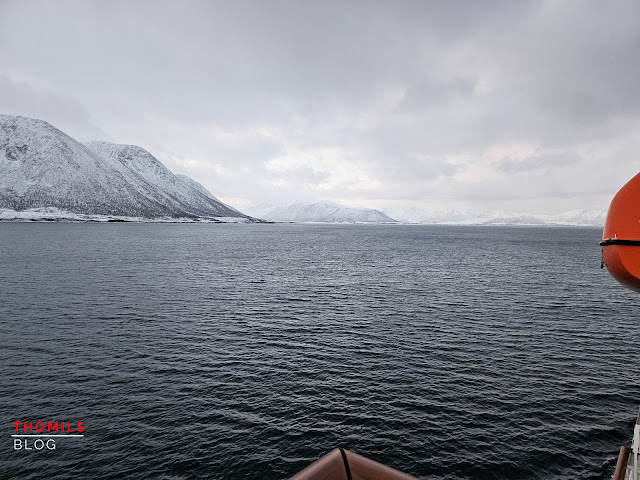





With the weather clearing, and most of our passage today happening in the protected inner sounds along the coast, I decided to head out front to the fo’c’s’le on Deck 6 to watch our approach to the first port of the day, Risøyhamn. Havila Castor would make her way there by passing through the Risøyrenna, or Risøy channel. Back when the coastal route had first been established back in the 1890s, this area had been a major obstacle for shipping. Whilst the Risøy channel as such has been a feature of the local landscape for ages, splitting the island of Andøya from the Norwegian mainland, it is also very shallow, rendering it impassable to even moderately sized ships, who were forced to take an hours-long detour around the entire island of Andøya, through a sea area where the continental shelf falls away to the abyssal plains of the North Atlantic almost within sight of the coast. This creates some truly atrocious sailing conditions, even by Norwegian standards, and thus by the early 1900s, the decision had been made to literally blast a navigable channel through the Risøy sound, the aforementioned Risøyrenna. One of the rocks blasted out of the seabed was presented to the Norwegian king upon the opening of the channel and is now preserved next to the quayside in Risøyhamn.




The outside of Deck 6 was still pretty slippery when I made my way out, and so I stayed relatively far back as we silently made our way through the channel, running on batteries, our path marked by navigational markers on both sides of the deep water, with ragged, snow-covered peaks standing silent vigil obver this at once extraordinary and everyday spectacle. For all the spectacle of our approach, the port of Risøyhamn itself was pretty as-you-like-it, with much of the visible town made up of 1960s and 1970s pre-fab houses. Whilst a few intrepid travellers ventured out from the ship to check out the town or the aforementioned rock, we were still running behind schedule and so, a short blast from the ship’s horn soon sent those tourists scurrying back to the ship in order to not get left behind. I wonder what the locals make of this spectacle?
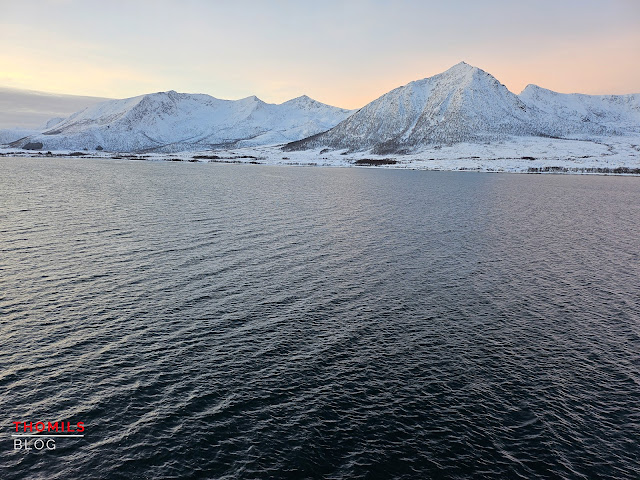

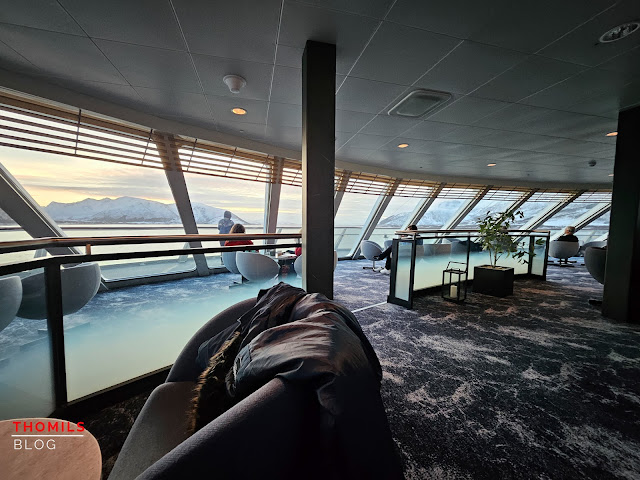



Owing to hour ongoing delay, we were soon underway again, passing underneath the road bridge that links Andøya and Risøyhamn to the mainland. I didn’t know where to look first as Havila Castor slowly kept pushing through the seemingly endless sounds that dominate this part of the coast. Our next port, Sortland, was literally just “up the creek” from Risøyhamn, and we arrived there in short order, the surrounding mountains still drenched in the pastel orange and pink hues of the seemingly perpetual dawn. As a result, I soon found myself back out on the fo’c’s’le for our arrival, not least because we were expecting a bit of spectacle. Earlier in the morning, Havila Castor had landed a sizeable shore party of tourists for a bus tour through Vesterålen, a tour that was timed in such a manner that the tour bus would cross the road bridge across the Sortland Sound just as we were passing under said bridge. And lo and behold, it once again worked out like a charm, with large numbers of passengers out on the decks of the ship welcoming the arriving bus by waving our arms and Norwegian flags, whilst the bridge crew let out a welcome with the ship’s horn.




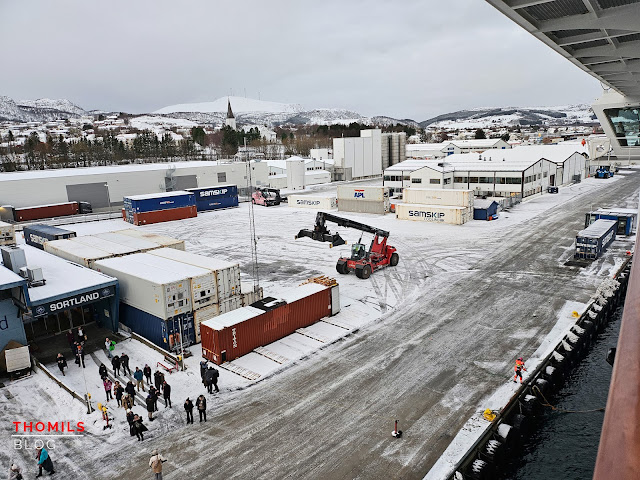


With that welcome out of the way, we made our way past the HQ of the Norwegian Coast Guard towards the dock in Sortland. We were still running behind schedule, so once again, our stay was cut down to the bare minimum. We offloaded a few pallets of cargo, welcomed the shore party back aboard, as well as a number of locals, and were soon back on our way through the interminable sounds and inlets of the Norwegian coast. We were coming home. To Stokmarknes, that is, the home of Richard With and the hurtigrute. It was here that the Vesterålen Steam Ship Company was founded in 1881 by Richard With and other local businessmen, and it was one of the first ports of call of the regular steamship service along the Norwegian coast served by the steam ship Vesterålen in 1893, a service that would evolve into the Norwegian Coastal Route of today. The route, and the company that would eventually evolve into Hurtigruten, have always been an important part of the town and so it should come as no surprise that there’s a massive museum in the city. In fact, it’s located right next to the terminal used by coastal route ships and houses the former Hurtigruten ship MS Finnmarken.





The sun had already set by the time we made our approach to Stokmarknes, casting the landscape in the fading red and orange hues of a fading day, and giving way to a seemingly eternal blue hour. The clear skies, light spilling out from the terminal and the smattering of people waiting near the terminal gave the scene a vibe that was at once eerie and homely, invoking memories of the works of Swedish artist Simon Stålenhag. It only needed an uncanny robot or floating vehicle to complete the illusion. Instead, what the scenery got was a stream of passengers departing the ship to take advantage of our hour-long stay and head to the Hurtigruten museum. I opted against joining them as I didn’t relish the prospect of being swept through the museum with all the speed of a Japanese tourist group and only getting glimpses of what I actually wanted to see. Instead, I opted to remain aboard and just enjoy the incredible landscape around me.




Night was falling by the time Havila Castor slipped her moorings in Stokmarknes and began to make her way across the expands of the Hadselfjord and into the Raftsundet, the narrow channel that separates Vesterålen from the Lofoten islands. I’d hoped that we’d have at least some more daylight left to enjoy the passage but all was not lost. During the daily briefing, the expedition team announced that the conditions were near enough perfect to once again enter the Trollfjord, one of the highlights of the journey and one that I’d missed on our way north. The fjord isn’t very long, only around two kilometres. But it is narrow, and whilst it widens towards the end, the entrance is only a hundred meters wide, framed by mountains reaching up to 1100 meters on both sides.



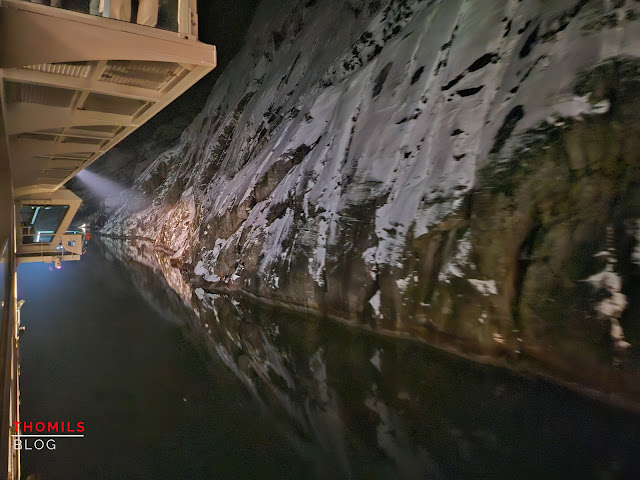





It was here that Havila Castor’s hybrid propulsion plant really began to shine. We entered the fjord on battery power, and whilst ventilators and air conditioning units naturally still produced some noise, it was otherwise utterly silent was we made our way further in, the waters of the fjord audibly splashing against our hull, the surrounding landscape dimly lit by the light escaping from the ship’s panoramic windows. Without warning, two bright cones of light began dashing across the waters and the walls of the fjord, searching, probing, exposing sheer rock one moment, and the smooth, undisturbed waters another. The bridge crew had turned on the ship’s search lights, their bright beams only serving to further illuminate the stark, breathtaking scene all around us. The sheer beauty and magnificence of this spectacle spread throughout the ship and even the loudest of my fellow passengers were stunned into silence as the ship edged deeper and deeper into the fjord. The jagged peaks of the surrounding mountains blocked out all but the highest stars and apart from our ship, only the modest lights from two hydroelectric plants set into the walls of Trollfjord shed any light onto the scene as Havila Castor finally entered the widest part of the fjord and began to turn around. The spectacle began to fade as we made our way once again through the narrows and back into the Raftsundet. By the time our bow swung around to south for the remainder of our voyage to Svolvær, the gas engines had kicked in again, and fast-moving low clouds set the scene for the next few hours. We had been lucky to be granted this nocturnal spectacle!
With that, it was on to Svolvær, the capital of Lofoten and a port that I’d mostly missed out on during our northbound voyage. Clouds had descended by the time we arrived at our berth, with the odd snow shower thrown in for good measure, and the winds were beginning to pick up, which made getting any pictures of the city or the surrounding scenery a bit of a challenge. Still, it was quite the sight, with many of the rocks and skerries surrounding the port being covered by massive wooden scaffolds used for drying cod, still the main export of Lofoten. In fact, the passenger atrium of the Hurtigruten terminal in town was shaped like one of those scaffolds. Continuing the theme for this southbound journey, we were still running behind schedule and so our port call in Svolvær was once again cut short, being only long enough to land some cargo and let go a surprisingly large number of passengers, many of whom seemed to be locals, given the prevalence of trolley cases.


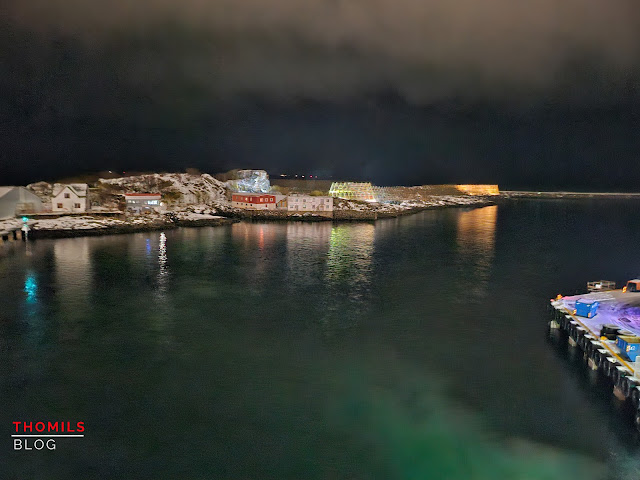
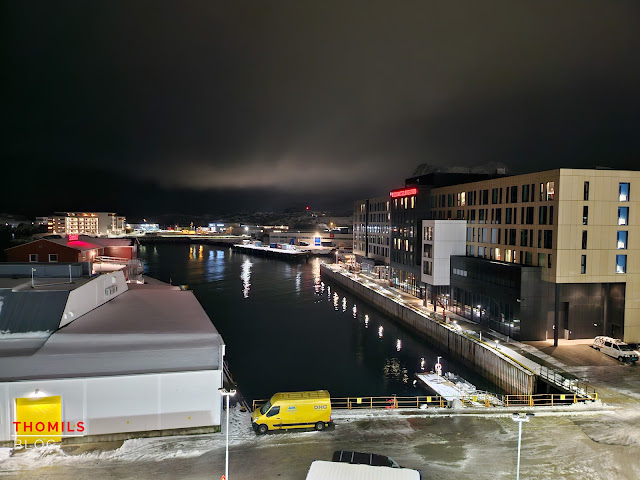

The seas began to pick up as we left Svolvær and began to make our way up the rugged coast of the Lofoten islands, retracing our journey a few days earlier. Dinner was a bit of a challenge, given the wave action, and it speaks to the type of day we had that I took almost no note of what was on the menu for that particular day. I do remember clearly noting the sheer discrepancy of having a three-course meal whilst sailing along one of the roughest, most remote stretches of the Norwegian coast, a country that isn’t exactly short of rough, remote coastlines. And indeed, our late night port call in Stamsund felt like a visit to the end of the Earth, with the waves, still increasing wind and snow showers only further adding to the forbidding scenery playing out outside my cabin window. As the waves began rocking our ship on its way past the Stamsund breakwater, I decided to call it a night, popped a seasickness tablet, and turned in.























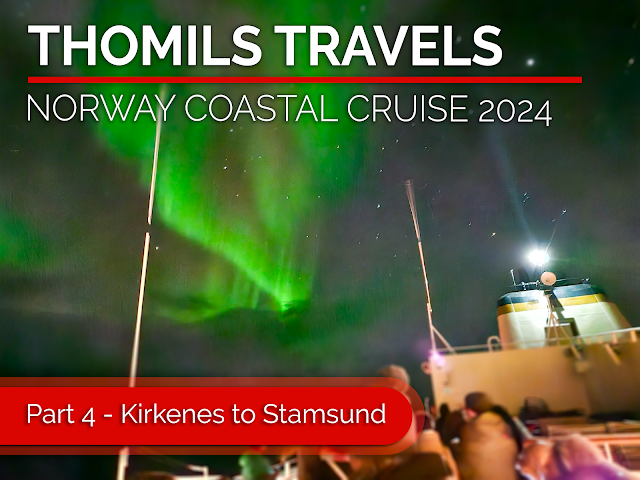





















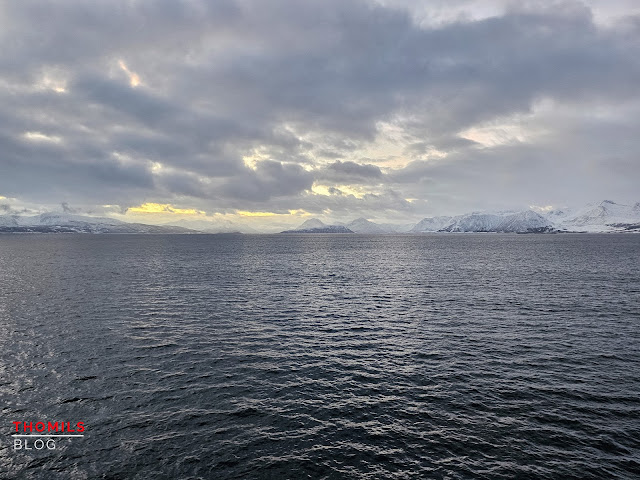

















































Comments
Post a Comment